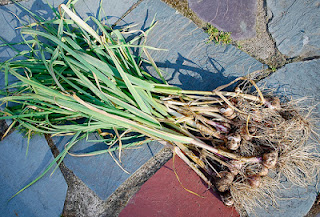Carp Garlic Festival. On a Saturday in mid-August, the Farmer's Market hosted the 13th Annual Garlic Festival. It's the second year I've attended and like last year, I found it educational, entertaining and a good-eatin' time.
Upon arriving, I first did a circuit of all 20 plus garlic booths, featuring more garlic than you can imagine in any one place. I took in the aroma of fresh garlic bulbs, marvelled at the intricate garlic braids (ouch the price!), watched braiding demos, and garlic cooking contests and sampled a wide variety of garlic-inspired condiments.
Circuit done, I honed in on buying one of each type of garlic, and remembered to bring paper bags and a marker so I could label them properly. Like who knew? there was such a variety of garlic to be used for cooking, or roasting, or eating raw.
So why do I like garlic? My taste for it has grown in the past decade as has my taste for stronger flavours and Chinese, Japanese and Asian-inspired cooking. It has a bunch of reputed health benefits such as helping to reduce blood cholesterol levels and blood pressure. Well, I'm all for that.... It also supposed to keep insects (like aphids) and fungal diseases at bay in gardens.
Garlic also stores well. If kept in a dry, not sunny, not too hot spot, it can last for months. Last year's batch lasted well into February. It flavoured all of last year's August pesto batches.
It took me awhile to figure out the differences in garlic. Some quick facts I've found thanks to Railway Creek Farms in Madoc, Ontario, and their site that publishes a complete guide to organic garlic, like...
* Garlic originated in central Asia, where they have cold winters and damp springs.
* There are 600 varieties in the world (unsure how many types are grown in Canada).
* The garlic species is divided into "hardnecks" and "softnecks". Hardnecks are favoured by northern growers while softnecks are better for warmer climates.
* Garlic 'scapes' are the plant at the top of the garlic. In recent years, growers are harvesting these separately from the garlic. Their mild taste makes them perfectly suited for stir frys and salads.
* Elephant garlic is very popular but is actually most closely related to the leek family.
Hardneck Garlic:
* Got its name from the stiff stalks or neck of the plants. It tends to have fewer cloves, with cloves circled around a central stalk.
* Hardneck garlic has 3 distinct varieties: Rocamboles (thinner skins, peels easily), Purple striped (distinctive stripes; can be mild to pungent tasting) and Porcelain (plump bulb and a few fat cloves with a thick outer skin).
Softneck Garlic:
* Stores and travels better than hardneck garlic.
* Two types are Artichoke (most commonly grown commercial garlic because it stores well) and Silverskin (silvery, white skins with many small cloves, stronger flavour). (I didn't find any silverskin.)
Here's a rundown of my new inventory of garlic. I bought a range of garlic (1-2 each) from the varieties offered at the Garlic Festival.
Rocamboles Variety
 |
| Spanish Roja |
Spanish Roja: Hot, with a distinct strong flavour and a lingering sweetness. Can be eaten raw, has a pleasant bite and is easy to peel. An award-winner.
Hungarian: Very hot with a lingering strong flavour. Very good for cooking.
 |
| Killarney |
 |
| Russian Red |
Italian: Garlicky with a lingering aftertaste. Works well rubbed on toasted bread and garlic butters. Cooks suggest it be added at the end of cooking to preserve the flavour.
Korean: Mild garlic flavour when cooked and with a nice large size.
Railway Creek Garlic: A mild garlic with a sweet aftertaste. Good on salads and light cooking. Guides suggests it be added at the end of the cooking time to retains its crunch and rawness.
 |
| Yugoslavian |
Yugoslavian: Very distinctive, with copper veined and purple blotched bulbs. It has a strong garlic aroma, initially hot and spicy but not overwhelming and then mellowing to a warm pleasant, sweet aftertaste. Averages 9 to 14 cloves per bulb.
Purple Stripe Variety
 |
| Persian Star |
Czechoslovakian: Rated the 'hottest' garlic at the Carp Garlic Festival a few years ago, this garlic has a bold, garlic flavour.
Persian Star: This garlic is an endangered heritage garlic, and hard to find. It has a mild, spicy zing.
Porcelain Strain Variety
 |
| Mennonite |
German: Very similar to Mennonite.
Siberian: Medium to strong flavour, 7-9 cloves per bulb.
 |
| Music Garlic |
Armenian: A large-cloved garlic that averages 4 cloves per bulb.
Music: This hardy, large garlic is very popular at the Farmers' Markets around the Ottawa Region. It is easy to grow, likes cold weather, stores for 3-6 months, is large and easy to peel. Its flavour is mild to medium hot, with high levels of allicin, which researchers say is a powerful antioxidant.
 |
| Rosewood |
Artichoke Variety
 |
| Red Inchelium |
 |
| Red Toch |
 |
| Polish White |



No comments:
Post a Comment